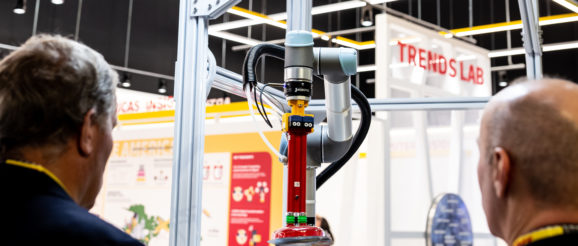Deutsche Post DHL opens innovation center for Americas


If things break right for express and logistics giant Deutsche Post DHL (DPDHL), many of the products and services it rolls out across the Americas over the next 50 years will spring from the building that opened September 12 in the Chicago suburb of Rosemont, Illinois.
The company’s Americas Innovation Center will join similar complexes in Cologne, Germany and in Singapore, effectively closing the geographic loop over the company’s innovation activities. (Ancillary facilities will open, as needed, in Australia and New Zealand.) The three main facilities will share ideas and processes, and DPDHL executives expect a great deal of intercontinental collaboration among the locations.
The 28,000-square-foot Americas facility opened just 13 days shy of the 50th anniversary of DHL’s founding, when entrepreneurs Adrian Dalsey, Larry Hillblom and Robert Lynn took the first letters of their last names as the company’s brand, began flying documents and parcels between San Francisco and Hawaii, and laid the groundwork for what would become the world’s largest express network, with operations in 220 countries.
In most countries outside of North America, DHL is the most recognized express delivery brand, and holds the top market position in many of them. It also operates the world’s largest contract logistics provider, the world’s largest air freight forwarder, the second largest ocean forwarder and a fast-growing, albeit from a smaller scale, e-commerce business.
Four of the company’s five units got in front of the worldwide media on September 10 and 11 to showcase their capabilities (the company’s intra-German mail and parcel unit did not attend) and to forecast what the global logistics business would look like in 2050. Some of the predictions ranged from ambitious to outrageous; the latter was embodied by the notion of taking a product in digital form, running it along a data network that no one can conceive of today, and have it rebuilt at its destination into the actual item. A less-fanciful projection, announced in March 2017, is to reduce the company’s logistics carbon footprint to zero by 2050. About one-quarter of its 34,000 vehicles worldwide will run on alternative fuels by 2020, it said.
If there were two overriding themes among a week of many moving parts, it was the profound implications of e-commerce on globalization and digitalization, and the need to automate many manual functions that, in regions like the U.S., have become expensive and labor-constrained. Labor accounts for 40 percent to 60 percent of all U.S. warehouse costs, while last-mile delivery, much of which is related to labor, comprises 41 percent of total supply chain costs, according to DPDHL executives.
Respondents to a global survey by consultancy CapGemini said that last-mile delivery costs them, on average, $10 per transaction, but that the customer – in this case the end consumer – pays, on average, only $8. Millions of customers pay nothing at all, getting their deliveries without directly paying for them.
Much of the innovation seems to be targeted at e-commerce, where, in the words of Ken Allen, DPDHL’s global head of e-commerce solutions, “anyone can be an entrepreneur and anyone can be a customer.” The major challenge is to reduce the incidence of shopping cart abandonment, which the company pegs industry-wide at 70 percent. Lee Spratt, who heads DPDHL’s Americas e-commerce unit, said that figure is actually a significant improvement from a 95 percent cart abandonment rate five years ago.
One of the key steps in driving down abandonment frequency, especially in international e-commerce, which is growing at a 20 percent to 25 percent annual clip, is to develop websites that are customized to each market and to build “landed cost” models that total up all the costs associated with international moves and present them clearly to the customer, DPDHL executives said.
What constitutes innovation is in the eyes of the beholder, and it is reasonable to ask what real-world breakthroughs emerge from these laboratories. DPDHL can point to research and development in robotics technologies, which began in its fulfillment centers in 2016, and expanded during 2017 and 2018 with the first major implementations at DHL and customer operations. There have been more than 130 robotics initiatives to-date, most of them with DPDHL customers.
DPDHL, which was one of the first logistics operators to use robots for warehouse picking functions, is working on building self-driving robots it said can increase picking rates up to 200 percent.
DHL Supply Chain, the company’s contract logistics unit, said it uses automated guided vehicles that can ferry goods through warehouses, mobile robots that can facilitate order fulfillment in e-commerce operations, and collaborative robots designed to help with repetitive tasks, such as picking and packing.
DPDHL typically enters into partnerships with technology start-ups. It does not have a venture capital arm similar to the UPS Ventures incubator operation of UPS Inc. (NYSE:UPS).
